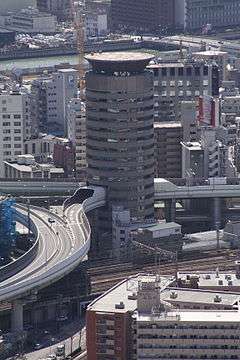Gate Tower Building
| Gate Tower Building | |
|---|---|
| ゲートタワービル | |
 | |
 Location within Japan | |
| General information | |
| Type | Office building |
| Location | 5-4-21 Fukushima, Fukushima-ku, Osaka |
| Country | Japan |
| Coordinates | 34°41′53″N 135°29′23″E / 34.698102°N 135.489629°ECoordinates: 34°41′53″N 135°29′23″E / 34.698102°N 135.489629°E |
| Completed | 1992 |
| Client | Suezawa Sangyō Co. Ltd. |
| Height | 71.9 m (236 ft) |
| Technical details | |
| Structural system | Reinforced concrete and partly steel frame |
| Floor count | 16 above ground, 2 underground, 1 elevator equipment tower floor |
| Floor area | 7,956 m2 (85,640 sq ft) |
| Design and construction | |
| Architect | Azusa Sekkei, Yamamoto-Nishihara Kenchiku Sekkei Jimushō |
| Main contractor | Sato Kōgyō Co. Ltd. |

Gate Tower Building (ゲートタワービル gēto tawā biru) is a 16-story office building in Fukushima-ku, Osaka, Japan. It is notable for the highway that passes through the building.[1]
Overview
The building has a double core construction, with a circular cross section. The Umeda Exit of the Ikeda Route of the Hanshin Expressway system (when exiting the highway from the direction of Ikeda) passes between the fifth through seventh floors of this building. The highway is the tenant of those floors. The elevator passes through the floors without stopping: floor 4 being followed by floor 8. The floors through which the highway passes consist of elevators, stairways and machinery. The highway does not make contact with the building. It passes through as a bridge, held up by supports next to the building. The highway is surrounded by a structure to protect the building from noise and vibration. The roof has a helipad.
History
A wood and charcoal business held the property rights for this plot of land since the early Meiji period, but the gradual move to other sources of fuel resulted in the deterioration of those company buildings. In 1983, redevelopment of the area was approved, but building permits were refused because the highway was already being planned.[2] The property rights' holders refused to give up, and negotiated with the Hanshin Expressway corporation for approximately five years to reach the current solution.[1][3]
Although normally highway corporations purchase the land they build a highway on or over, it is not guaranteed to succeed and therefore issues like this can arise. For that reason, the highway laws, city planning laws, city redevelopment laws and building codes were partly revised in 1989 to allow the unified development of highways and buildings in the same space. This system was originally designed to facilitate the construction of the second Ring Road in the vicinity of Toranomon, Minato-ku, Tokyo, but in the end was not applied there. Instead, the system was put into effect in the construction of the Gate Tower Building, becoming Japan's first building to have a highway pass through it. Normally, highways are still built underground in these cases, and passing through a building is an extremely rare occurrence.
Profile
- Address: 5-4-21 Fukushima, Fukushima-ku, Ōsaka City, Ōsaka Prefecture
- Completed: 1992
- Site area: 2,353 m2
- Construction area: 760 m2
- Total floor area: 7,956 m2
- Structure: Reinforced concrete and partly steel frame
- Height: 71.9 m
- Floors: 16 floors above ground, 2 floors underground and 1 top semi-tower floor used for elevator support machinery
- Purpose: Office building
- Client: Suezawa Sangyo Co. Ltd.
- Designer: Azusa Sekkei and Yamamoto-Nishihara Kenchiku Sekkei Jimushō
- Builder: Satō Kōgyō Co. Ltd.
See also
References
- 1 2 "Are these the most outrageous hotel designs ever?". News.com.au. Retrieved 16 June 2015.
- ↑ [El Gate Tower Building de Osaka, o cuando las autopistas atraviesan edificios Artículo publicado en Japonismo: El Gate Tower Building de Osaka, o cuando las autopistas atraviesan edificios http://japonismo.com/blog/el-gate-tower-building-de-osaka-o-cuando-las-autopistas-atraviesan-edificios "El Gate Tower Building de Osaka, o cuando las autopistas atraviesan edificios"] Check
|url=value (help). Retrieved 16 June 2015. - ↑ "10 Bizarre Buildings And Their Fascinating Histories". Retrieved 16 June 2015.
External links
- Sato Kogyo construction achievements
- Hanshin Expressway Corporation
- Hanshin Expressway and Gate Tower Building Photoset